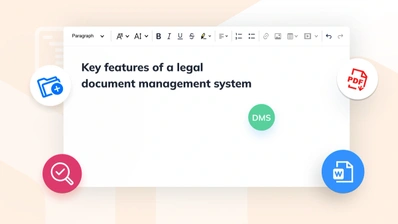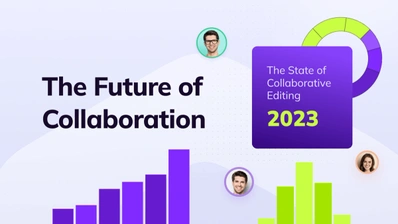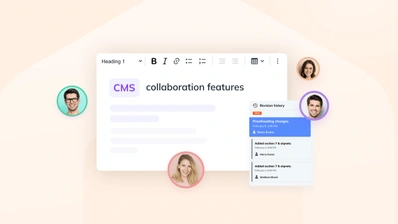Document collaboration - how CKEditor helps break down barriers to success

What is document collaboration? Alternately referred to as document sharing and file collaboration, it is a process of individuals working collaboratively on a team or a company project, which takes the form of a readable document. Document collaboration is useful not only for the remote work now common to our professional lives, but also for solidifying teams and establishing the necessary space for multiple parties to create documents and work together on wider projects.
CKEditor is a document collaboration tool that happens to also be an industry leader in rich-text editing and collaborative editing overall. Not only do we provide real-time collaboration and rich-text editing solutions using WYSIWYG technology, but we see who could potentially use our tools as well. Though the benefits of collaboration are useful, obstacles to successfully collaborating still exist. We feel collaborative tools are key to overcoming these obstacles even in the most competitive and individualistic of professions.
What separates CKEditor from the likes of Dropbox Paper, Microsoft Word, or Google Docs is that it can be integrated into other solutions or CMS a company may already use and rely on. It can make the workplace much more efficient and integrated without solutions having to be used from different providers and apps opened back and forth. Companies do not have to share files, for instance, with Google or Microsoft when using such an integrated solution and worry about what format a file is being shared in.
Collaboration in law - all for one, one for all
A study by the Harvard Business Review’s Heidi K. Gardner took the idea of collaborative work and applied it to law, one of the most notoriously individualistic professions. The author recognized several obstacles to team collaboration, all of them having the same thing at their core: a lack of trust.
Established partners can be reluctant to bring new hires up to speed on their areas to expertise. The path to success in the legal world is based on individual markers of success such as grades, school admissions processes, and peer reviews. As such, partners may hoard work, such as contract negotiations, from their fellow junior lawyers in a selfish bid to maintain their autonomy. One way new hires can become quickly familiar with established practices is to help in co-authoring important documents for the firms. A modern way to do this is by using smart software that learns your practice’s manner of work during the back and forth of legal document collaboration.
A speedy document collaboration software solution can be an indispensable part of this integration. An example of such software is made by the startup Agreemint, who sees that determining priorities for each party in a business partnership, as well as responsibilities for document architects, are of equal and vital importance. Agreemint’s contract lifecycle management solution allows users to set permissions for editing contract drafts, as well as protect sections to prevent unwanted changes to optimized clauses. It also uses CKEditor 5’s Track Changes that allows users to not just edit, but to rank the importance and sensitivity of the edits from your side.

Agreemint also takes advantage of CKEditor 5’s Comments feature to allow internal commenting between writers, or external commenting between negotiating parties, so legal team members can discuss edits before publishing changes for the other side to see. It’s an example of document management software that allows mutual trust to be built. Established partners can loop in others without too much of their workflow being interrupted. Similarly, new legal hires can earn practical learning experience by learning the quirks of their own team’s partners (not to mention those of their counterparts) while having the opportunity to contribute early on in their tenure. Thus, a mutual way to work together is created.
Document co-authoring and how to integrate teams properly in market analysis
Aligning content from different sources is a problem even in many professions where working in tandem is the law of the land. Take analyst relations, for example, where information crucial to deal-making moves in a constant flow between companies and analysts. Constantly requiring mistake-free and relevant information, analyst relations is a field where the ability to collaborate with online document creation, editing, and comments requires multiple levels of checks and improved accuracy.
Platforms like Spotlight help facilitate the connections required in analyst relations. They take an insights-driven approach to AR and strive to provide immediate support for any and all informational needs. What’s more, building a strong trust is also required, and being consistent and punctual with data is a must. In order to keep the information flowing smoothly, Spotlight equips their solution with CKEditor 5’s rich-text editing features so that analysts can keep track of their plans, activities, and program objectives all within documents.
Furthermore, CKEditor 5’s real-time collaboration features enable multiple analysts to work on the same document at once, ensuring that urgently-needed analysis is delivered to meet even the most pressing deadlines. Even though analysts might be well-integrated with each other, whether in one firm or across multiple, CKEditor’s software provides that extra push to bring it all into sync.
Document collaboration tools in market research - a central place for work
Another pitfall Gardner mentions is inefficiency, which applies to a wide swath of the corporate world, which boils down to finding the exact right people at a firm who are up to tackling a given project. Though work in the COVID era has made colleagues easier to track down, her point still resonates. In document collaboration, the process of getting notes and plans down in one place can still be aggravating. However, keeping track of any and all ideas to make an ad campaign is absolutely vital in the field of market research.

That’s why Maru Group, another CKEditor 5 client, uses our rich-text editor as the backbone of its text input for its HUB product. Output of the HUB app includes comments, content, and release notes, all of which are essential to marketing. They also use it to power “Collab” – a real time collaborative document writing facility in HUB so that research teams can collaborate live on survey design, briefs, and reporting outputs among other things.
All the writing done with CKEditor 5 lives online in HUB and is not only connected to other project assets, but also meets their clients’ security and compliance obligations, thus it helps teams be more efficient. The result is not only better internal collaboration, being able to edit a document and thus refine what is being worked on, but a better finished project for clients.
The pitfalls of trust and inefficiency can be overcome by knowing the value of collaborative authoring tools. The innovative use of CKEditor’s collaborative writing technology can have an impact on your team’s overall output and will eventually affect your company’s bottom line. Be sure to give one of the hottest document collaboration tools in 2022 a look and make your online collaboration smoother within your company. We look forward to answering the call to support other document collaboration initiatives wherever they may be.
You can read more on the topic of collaboration in our blog posts:
- Real-time collaboration - 7 greatest benefits - CKEditor 5
- How collaboration lets companies innovate more and better - CKEditor 5
- Tackle too many unproductive meetings - CKEditor 5
- Healthcare SaaS: How innovative software solutions are transforming the medical industry
- Best practices of remote work are at CKSource - Come join us!
- Content collaboration best practices in a nutshell - CKEditor 5
- Remote collaboration - Software that improves working from home - CKEditor 5
- Collaborative writing and how to implement it in your application


